Simplified Analytical Method for Estimating the Resistance of Lock Gates to Ship Impacts
Abstract
The present paper is concerned with the design of lock gates submitted to ship impacts. In this paper, a simplified analytical method is presented to evaluate the resistance of such structures under collision. The basic idea is to assume that the resistance is first provided through a local deforming mode, corresponding to a localized crushing of some impacted structural elements. For consecutive larger deformations, the resistance is then mostly provided through a global deforming mode, corresponding to an overall movement of the entire gate. For assessing the resistance in the case of the local deforming mode, the structure is divided into a given number of large structural entities called “superelements.” For each of them, a relation between the resistance of the gate and the penetration of the striking ship is established. However, as some results are already available in the literature, this subject is not treated extensively in this paper. On the contrary, the calculation of the resistance of the gate provided through the global mode is detailed and the strategy to switch from local to global deformation is highlighted. Finally, we propose to validate our developments by making a comparison between results obtained numerically and those predicted by the present analytical approach.
1. Introduction
Amongst all the loads that have to be expected for the design of lock gates, the collision of a vessel is one of the most difficult to handle.
A collision may result in some minor damages to the plating or to the stiffening system of the gate, producing, for example, a local loss of water tightness. However, if the initial velocity of the striking ship is large enough, the displacements imposed to the structure may cause a complete collapse of the gate. This would result in the emptying of the damaged reach, with probably the complete sinking of the striking ship.
To deal properly with ship impact, it is of course possible to use nonlinear finite element methods. Nevertheless, at the predesign stage of a gate, such approaches are rather restrictive because of the time required to model and simulate collisions. Therefore, we propose here to establish an analytical simplified method in order to verify the resistance of gates submitted to a ship impact.
For the moment, the development of such simplified methods is not really reported in the literature. Some very interesting results have been established for the purpose of analyzing collisions between two ships. For example, the crushing resistance of web girders has already been theoretically and experimentally studied by Wierzbicki and Culbertson Driscoll [1], Wang and Ohtsubo [2], Simonsen [3], Zhang [4], and Hong and Amdahl [5]. Each of them developed analytical formulations that may be useful for studying locally the contact between a ship and a gate.
Additional results are also available for impacted panels, which have been investigated in detail by Wang [6], Wang and Ohtsubo [7], and Zhang [8]. Some references are also useful for evaluating the resistance of metal plates after rupture, when they are submitted to tearing and cutting. For example, these phenomena have been studied by Wang and Ohtsubo [7], Zhang [8], Wierzbicki [9], and Zheng [10]. In the particular case of stiffened panels subjected to lateral loads, the developments performed by Paik [11], Cho and Lee [12], or Ueda et al. [13] constitute a very accurate basis for performing analytical estimation of the resistance of such structural components.
The previous brief literature review shows that some results are already available to deal with a simplified approach of collisions between ships and gates. All these developments constitute of course an invaluable help for developing simplified collision models of lock gates, but they are not sufficient. The principal reason is that the behavior of an impacted gate may not directly be assimilated to the one of an impacted vessel. Consequently, some researches in this domain are still needed.
- (i)
the local one, which implies a local crushing of all the impacted structural elements;
- (ii)
the global one, which supposes an overall deformation of the gate.
In the present paper, we try to go further into this philosophy.
2. General Description of the Problem
In this paper, we consider the exceptional situation of ship colliding with a lock gate. The collision scenario is depicted in Figure 1, where the general coordinate system is denoted by (X, Y, Z). For avoiding confusion in the present paper, we will use the terminology “transversal,” “vertical,” and “longitudinal” in accordance with the respective orientation of X, Y, and Z axes.
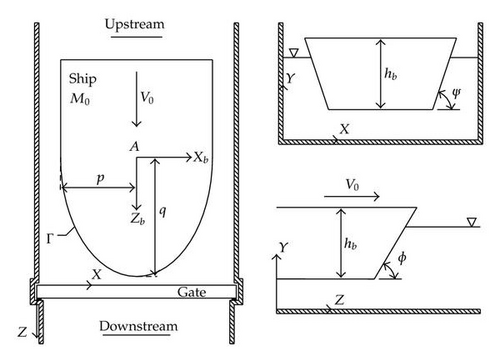
In our scenario, the vessel is coming from upstream, and, consequently, the impact is located on the downstream gate of the lock. It is clear that this case is the least desired because the hydrostatic pressure is acting in the same direction as the impact force. On the contrary, if the collision was happening in the downstream reach of the lock, the resulting hydrostatic pressure would act in opposition with the impact force and would compensate it partially.
In order to derive an analytic procedure for estimating the collision resistance of the gate, we first need to describe the ship and the gate using various parameters. This is the purpose of the subsequent sections.
2.1. Geometrical Description of the Striking Vessel
The vessel is characterized through the following: mass M0 and velocity V0. In other words, we assume a certain kinetic energy for the striking ship. These two parameters are chosen according to the waterway class, which determines the maximal speed as well as the allowable shipping of the vessels.
- (i)
the height hb between the uppermost deck and the bottom of the ship;
- (ii)
the side angle ψ and the stem angle ϕ, which are used to fix the inclination of the bow.
It is important to note that all the above mentioned properties are required input data, which have to be provided by the user before the beginning of the calculation process.
2.2. Description of the Gate
- (i)
the transversal frames, which may be seen as beams presenting a T-shaped cross-section; they are placed in the transversal direction (i.e., along the X axis);
- (ii)
the vertical frames, which are also beams with a T-shaped cross-section but are arranged in the vertical direction (i.e., along the Y axis);
- (iii)
the stiffeners, which are optional reinforcing beams disposed transversally on the plating in order to avoid instabilities in shells; their cross-section may exhibit various shapes.
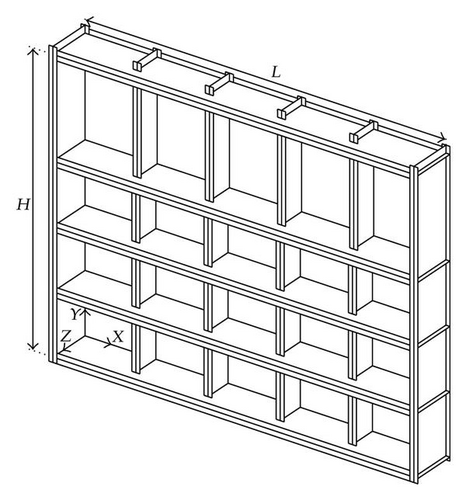
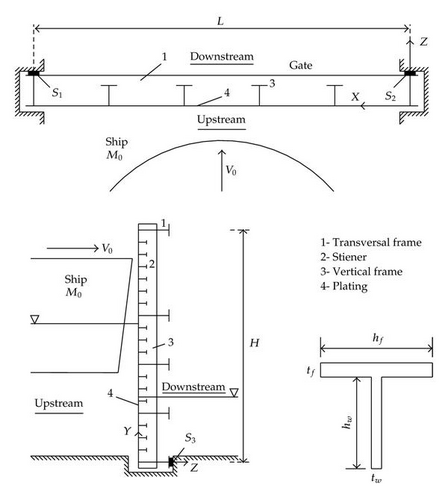
The geometric data required for characterizing the stiffening system are mainly the dimensions of the different cross-sections. As shown in Figure 3, the needed values are the height hw and thickness tw of the web, as well as the height hf and thickness tf of the flange. For the plating, it is only necessary to precise its thickness tp. With all these parameters and knowing the properties of the material constituting the gate, it is possible to derive the mechanical properties of all the stiffening elements.
- (i)
the gate is simply applied against the two lock walls (supports S1 and S2 in Figure 3). The translational degree of freedom in the Z direction has therefore to be blocked along the all vertical extensions of the gate in S1 and S2;
- (ii)
the gate is simply applied against the sill located at the bottom of the chamber (support S3 in Figure 3). Therefore, it seems to be reasonable to restrain the translational displacement in the Z direction along the all transversal extension of the gate in S3.
2.3. Description of the Material
The present paper is concerned with the resistance of a lock gate impacted by a ship. The primary goal is not to assess the damages caused to the vessel: we are much more interested in the ability aspect of the structural resistance to collisions. As a consequence, we assume that the material constituting of the striking vessel is infinitely rigid. In other words, we will not allow any deformation in the ship structure, which is a conservative approach in the evaluation of the resistance.
- (i)
the maximal elastic stress σ0, with which is associated the maximal elastic deformation ϵ0;
- (ii)
the rupture stress σu, for which tearing is observed in the material; the corresponding deformation is called ϵu;
- (iii)
Young’s modulus E characterizing the stiffness of the material during the elastic phase.
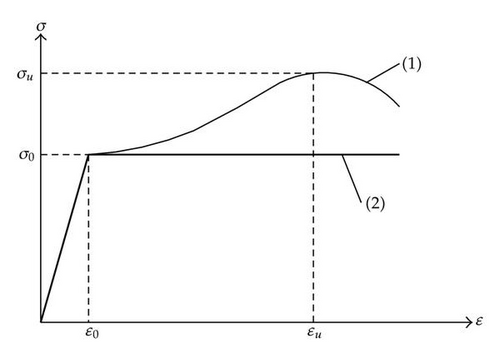
In order to simplify the analytical derivation of the collision resistance, we will suppose here that the steel has a so-called elastic-perfectly plastic behavior. This means that the relation between stresses and strains is idealized by curve (2) in Figure 4. Consequently, we neglect the additional resistance coming from hardening of steel, which is in fact a conservative assumption.
2.4. General Positioning in the Space
- (i)
the impact point E, that is, the point of the gate where the first contact between the bow and the plating will be established; this point is located by its coordinate (XE, YE), as shown in Figures 5 and 6;
- (ii)
the transversal positions Xi of the vertical frames, that is, the position of each vertical frame along the X axis (see Figure 5);
- (iii)
the vertical positions Yi of the horizontal frames, that is, the position of each horizontal frame along the Y axis (see Figure 5);
- (iv)
the total number of stiffeners distributed along the vertical height H of the gate.
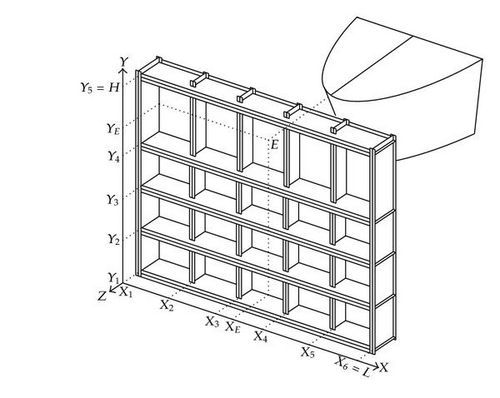
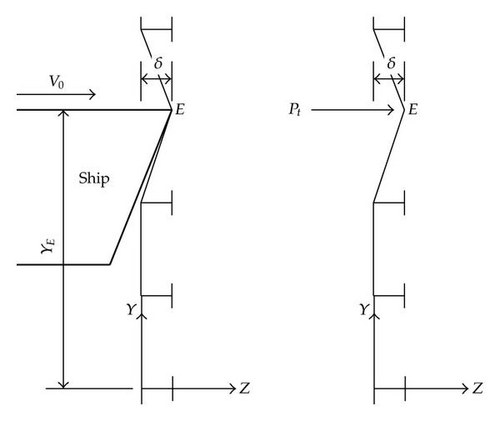
When all the previous inputs are placed, the three-dimensional configuration of the gate is completely defined.
3. Methodology for Evaluating the Collision Resistance
3.1. General Principles
When a ship collides with a gate, its action on the impacted structure may be represented by a force Pt acting in the same direction as the indentation δ of the striking vessel (see Figure 6). By equilibrium, this force may be seen as the resistance opposed by the gate to the progression of the ship. Therefore, the goal of our work is to assess the value of Pt for a given indentation δ of the vessel. In other words, our aim is to derive the evolution of Pt with δ by means of simplified analytical procedures.
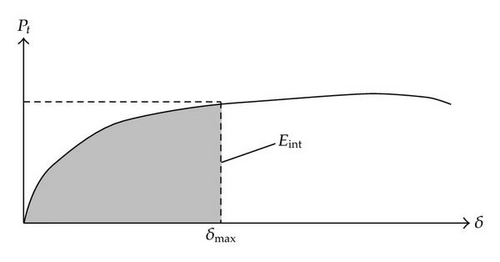
For a given ship of mass M0 and velocity V0, (3.1) and (3.2) give the maximal penetration δmax , which has to be supported by the gate to withstand an impact with such a vessel. According to the maximal degradation level accepted for the gate, it can be decided if this value of δmax may be applicable or not.
3.2. Theoretical Basis
The theoretical basis for deriving Pt(δ) is the so-called upper-bound theorem, which states that “if the work rate of a system of applied loads during any kinematically admissible collapse of a structure is equated to the corresponding internal energy dissipation rate, then that system of loads will cause collapse, or incipient collapse, of the structure.”
Consequently, (3.5) may be useful for deriving Pt(δ), provided that we are able to establish a relation between the deformation rate and the velocity . To do so, we need to define the displacements over the entire volume 𝒱. For example, in Figure 8, if we suppose that point A is moving to point B for a given value of δ, we may define the three components U1(X, Y, Z, δ), U2(X, Y, Z, δ), and U3(X, Y, Z, δ) of the displacement field along axis X, Y, or Z, respectively. Note that in the remaining part of this paper, we will also use the equivalent notations (U, V, W) and (X1, X2, X3) for designating (U1, U2, U3) and (X, Y, Z).

Equation (3.9) is the needed relation between Pt and δ. However, the crucial point in the above-described approach is to define properly a kinematically admissible displacement field, otherwise the upper-bound theorem may lead to an overestimation of the crushing resistance.
3.3. The Superelements Method
The integration of (3.9) has to be performed over the whole volume 𝒱 of the struck structure and is rather impossible to derive analytically. As a consequence, we need to simplify the procedure described here over, and this may be achieved by splitting the gate into superelements.
- (i)
The first superelement (SE1) is a rectangular plate simply supported on its four edges and impacted perpendicularly to its plane, undergoing therefore important out-of-plane displacements. Such elements are typically used for modeling the plating of the gate.
- (ii)
The second superelement (SE2) is a beam with a T-shaped cross-section, impacted in its plane. This kind of element is therefore quite relevant for modeling transversal and horizontal frames.
The division of the gate into superelements is only based on geometric considerations. In order to illustrate this process, we can consider, for example, only a small part of the lock gate represented in Figure 2, for which the division principle is shown in Figure 9. As it can be seen, the two previous types of elements are sufficient for analyzing the structure.
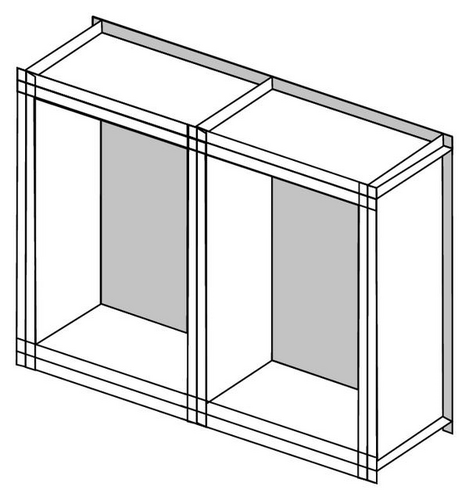
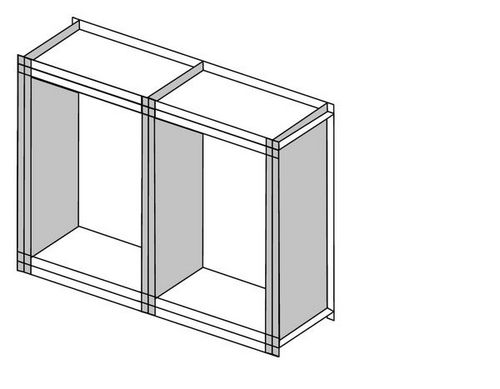
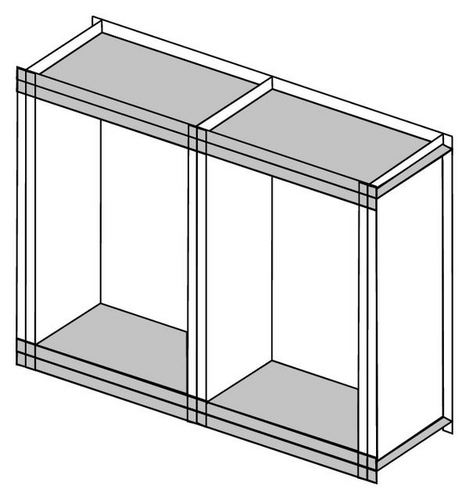
- (i)
is the stress tensor defined on the entire volume of superelement k,
- (ii)
is the strain rate tensor defined on the entire volume of superelement k,
- (iii)
𝒱k is the volume of superelement k.
3.4. Global and Local Deforming Modes
We previously assumed that each superelement was working independently from the others. This hypothesis remains valid as long as the penetration δ is reasonably minor. However, when the penetration δ of the ship is increasing, deformations will occur in superelements that still have not been undertaken by the bow. Consequently, the internal energy rate for superelement k may not be equal to zero, although it has not been activated. This may be seen on Figure 10, where out-of-plane displacements occur in the entire gate, even if some regions have not been impacted by the striking ship bow.
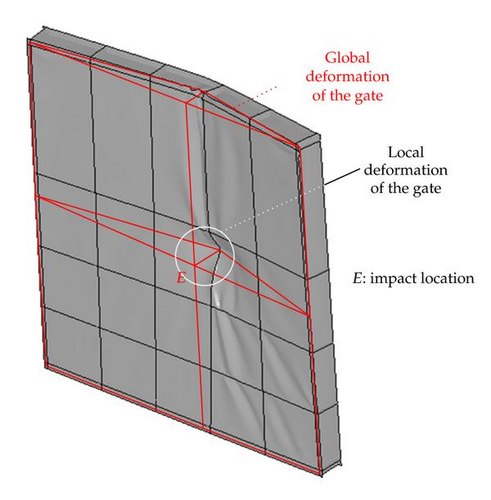
- (i)
We say that the structure exhibits a local deforming mode (see Figure 10) when the developments performed in Section 3.3 may be applied. In other words, we suppose here that the penetration of the vessel into the gate is only allowed by the local deformations of the activated superelements. Only the area impacted by the ship contributes to the energy dissipation; the other parts of the gate remain undeformed. Of course, it may be easily understood that the local mode is only valid for quite small values of δ.
- (ii)
On the contrary, we say that the structure exhibits a global deforming mode (see Figure 10) when the displacements are not confined in a small area located around the impact point. In this case, the entire gate is involved in the energy dissipation process and we may no longer assume that it behaves like a set of independent substructures activated progressively. Consequently, the superelements method is not valid anymore and the resisting force Pt has to be evaluated by another way than the one discussed in Section 3.3. This is precisely the topic of Section 5.
- (i)
the value of Pt obtained by supposing a local deforming mode; it is denoted by Ploc ;
- (ii)
the value of Pt obtained by supposing a global deforming mode; it is denoted by Pglob.
For a given penetration δ, Ploc and Pglob are then compared. As long as Ploc < Pglob, the force exerted locally by the ship is not sufficient to cause an overall displacement of the gate, so the ship continues penetrating into the structure by local indentation. However, as soon as Ploc = Pglob, the force becomes sufficient and the switch from the local mode to the global one is obtained. The corresponding value of δ is the required δt (see Figure 11). After that, for the values of δ greater than δt, the resistance Pt is evaluated using equations specially developed for the global mode (see Section 5).
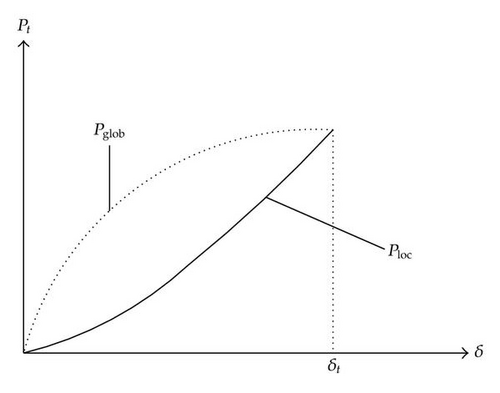
4. Evaluation of the Resistance in the Local Deforming Mode
In the local deforming mode, the resistance of the gate is given by (3.12), where we assume that the total resisting force is simply obtained by adding the individual contributions of all the activated substructures. In this section, the laws governing the behavior of the two types of superelements introduced in Section 3.3 are detailed. However, as this topic is already well treated in the literature (see e.g., [4]), in order to avoid any redundancy, we have made a quite concise presentation of our approach.
Note In the two following sections, we will use the superscript (k) for characterizing any property of the superelement number k.
4.1. Superelement Type 1 (SE1)
The first superelement is used for modeling the plating of the lock gate. Its boundaries are defined by the surrounding transversal and vertical frames, as shown in Figure 12. Considering the location of the impact point E, it is possible to fix the four parameters , , , and .
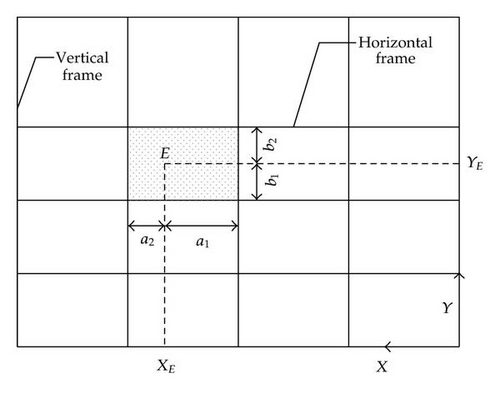
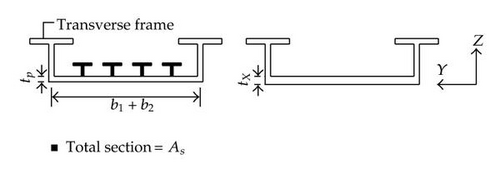
This correction has to be applied for the calculation of membrane effects in the X direction. However, if we consider membrane effects in the Y direction, the stiffeners have no influence and they do not need to be considered. Consequently, we have and the plate becomes orthotropic.
In the present approach, we suppose that the impacted plate is completely independent from the surrounding other superelements. Therefore, it is acceptable to consider the plate as simply supported on its four edges. For a given indentation δ, the superelement will undergo mostly a membrane deformation; the effects of bending remain negligible.
When superelement SE1 is impacted by the bow of the vessel, for a given value of δ, we may deduct the deformation pattern shown in Figure 14. With this displacements field, it is possible to evaluate the internal energy rate, which has already been done by Zhang [4].
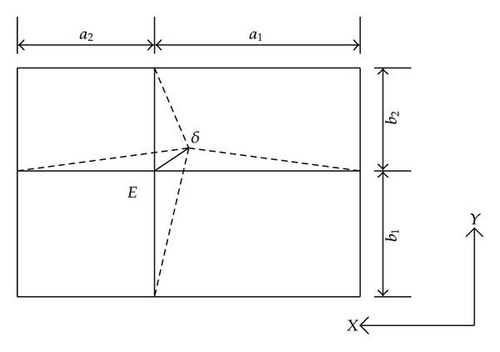
4.2. Superelement Type 2 (SE2)
The second superelement that we will consider is used for modeling the transversal and vertical frames. The boundaries of a horizontal superelement are defined by the two adjacent vertical frames (and inversely for a vertical superelement).
The principal dimensions and (see Figure 15) of superelement k are positioned in accordance with the location of the impact point. The resisting cross-section has a T-shape, whose properties are defined in the general geometry of the gate.
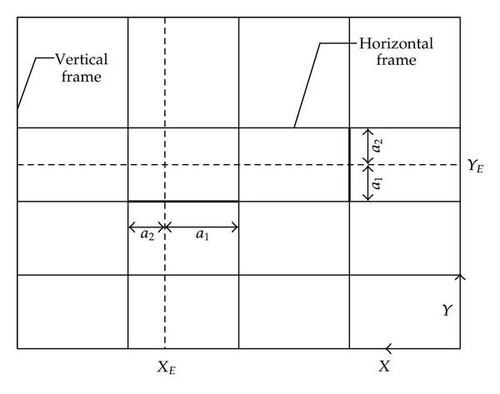
When this superelement is impacted, we suppose that it will deform like a concertina. To do so, three plastic hinges are formed. They are designated by ABF, ACF, and ADF in Figure 16. These lines allow for relative rotation between the triangular surfaces ABC, ACD, BCF, and FCD. Bending effects are therefore preponderant along these lines.
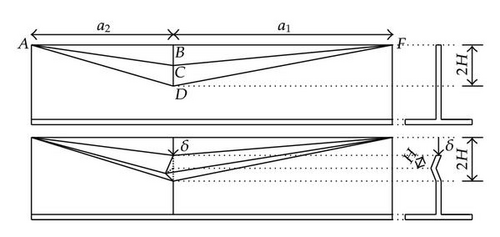
However, the rotational movement of the triangular surfaces is not free because it must respect the compatibility between surfaces ABD and BFD along their common line BD. Therefore, surfaces ABD and BFD are submitted to an axial extension implying mainly membrane effects. Consequently, for a given indentation δ, the web will be folded as represented in Figure 16, where 2H is the total height of one fold. According to the previous hypothesis, during this motion, the energy is absorbed by membrane extension of the triangular regions ABD and BFD, but also by bending effects in the three plastic hinges ABF, ACF, and ADF. The phenomenon of concertina folding has already been studied by a great number of authors. For example, it was theoretically and experimentally studied by Wierzbicki and Culbertson Driscoll [1], Wang and Ohtsubo [2], Simonsen [3], and Zhang [4]. Hong and Amdahl [5] compared all these various approaches and also developed their own model.
4.3. Total Resistance in Local Deforming Mode
5. Evaluation of the Resistance in the Global Deforming Mode
5.1. Displacements Fields
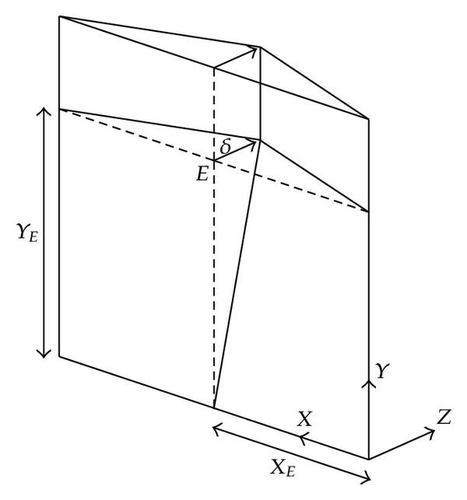
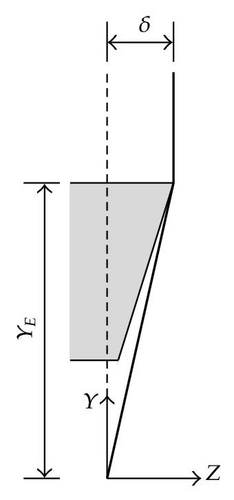
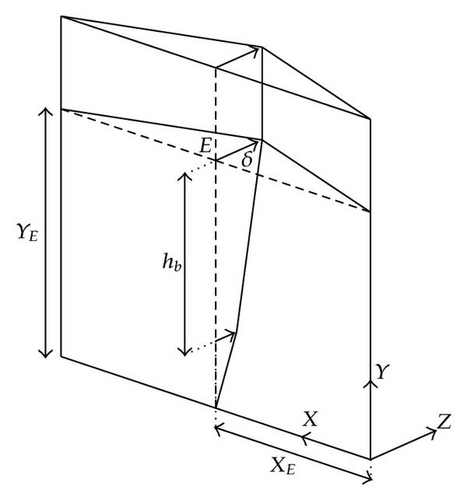
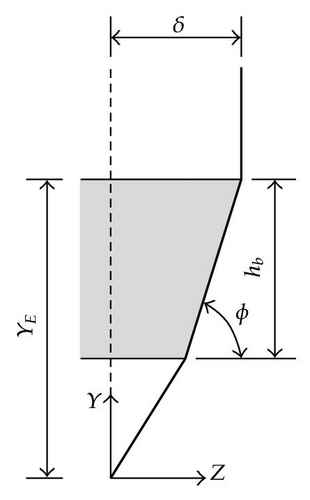
5.2. Mechanical Model of the Gate
In the previous section, we have postulated a kinematically admissible displacements field. In accordance with the upper-bound method, it is now possible to use the principle of virtual velocities in order to estimate the resistance of the structure deformed in the global mode.
Unfortunately, it is rather difficult to derive analytically the resistance of a gate submitted to the displacements given by (5.1), (5.3). In order to simplify the problem, we make the assumption that the main contribution to the resistance is coming from the bending of the gate between the two lock walls. This hypothesis seems to be reasonable for a global mode, especially when the ratio H/L is wide, but we have to bear in mind that it may not remain valid in some special cases. As a consequence, the resistance in the global deforming mode is mostly provided by transversal frames, the stiffeners. Therefore, the gate may be seen as a set of independent beams subjected to a given displacements field. The contribution of the vertical frames is only to apply the expected displacements to these beams; we suppose that they do not take part mechanically in the resistance. According to these hypotheses, we obtain the equivalent model of the gate depicted in Figure 19.
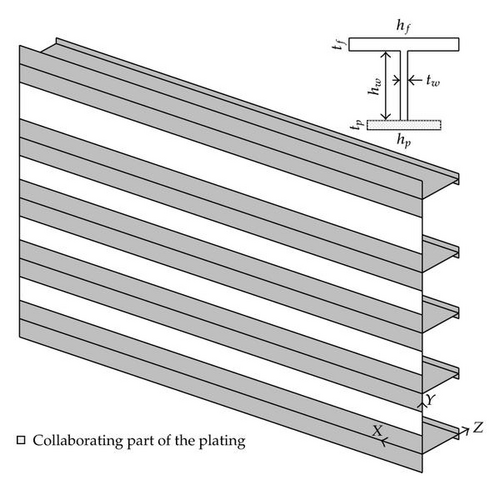
- (i)
the shear lag effect occurring at the junction between the plating and webs of transversal frames;
- (ii)
the overall buckling of the stiffened panel located between two transversal frames; this situation corresponds to the configuration (a) plotted in Figure 20.
- (iii)
the local buckling of the plating located between two stiffeners; this is illustrated by the configuration (b) in Figure 20.
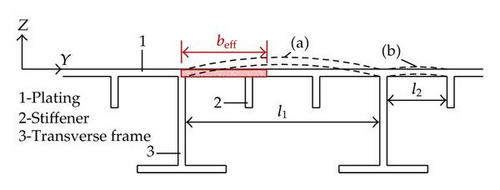
The calculation of the effective width beff (see Figure 20) on both sides of each transversal frame can be achieved by applying the rules provided by Eurocode 3 for longitudinally stiffened plates.
- (i)
a rotational restriction along the transversal X axis, which will hinder the torsional effects in the beams;
- (ii)
a translational restriction along the longitudinal Z axis, which will hinder out-of-plane shearing and bending of the beams.
Of course, it is rather difficult to precisely account for these effects in an analytical procedure. As we are not trying to have an accurate resistance of the gate (but a good approximation), it is admissible to consider that each beam is simply supported at both ends. By so doing, we completely omit the additional restrains provided by the vertical frames, which is a conservative hypothesis for evaluating globally the impact resistance.
5.3. Elastic Resistance
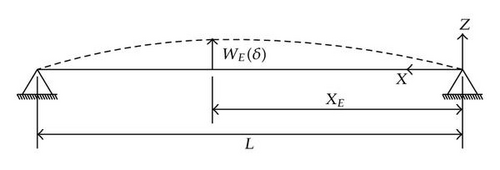
5.4. Plastic Resistance
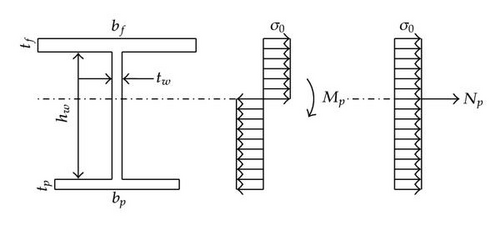
With these properties, a classical plastic analysis may be performed. As soon as is reached, the section located in X = XE behaves like a plastic hinge and the structure becomes a mechanism. At this moment, the yield locus characterizing the cross-section is reached. However, it does not mean that the resistance is not increasing anymore. As the deformations are increasing, tensile stresses appear inside the beam k, and the cross-section is submitted to both a normal force N(k) and a bending moment M(k). As they are linked by the equation of the yield locus, these two actions are not independent.
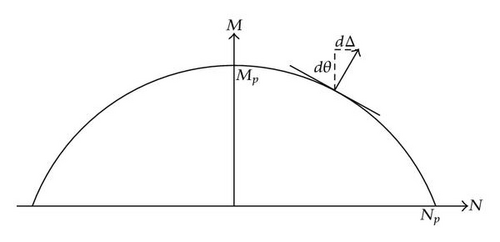
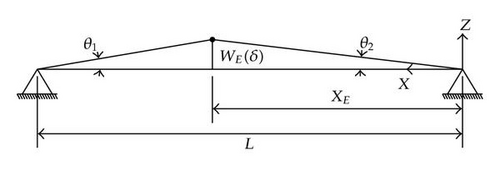
At this stage, it is important to note that this result implies that the beam is perfectly restrained in the axial direction. This hypothesis implies that no transversal motions (along direction X) occur at the supports where X = 0 and X = L. This seems quite reasonable for the gate under consideration because of the action of vertical frames. However, it is important to keep in mind that we have formulated such an assumption because even small displacements may reduce considerably the present foreseen resistance.
5.5. Total Resistance in Global Deforming Mode
6. Combination of Local and Global Deforming Modes
6.1. Resistance of the Beams Already Impacted during the Local Phase
- (i)
If Ploc > Pglob, then the force applied by the ship on the gate is not sufficient for activating the global deforming mode. Consequently, we have δ < δt and Pt = Ploc , with Ploc given by (4.5).
- (ii)
If Pglob = Ploc , then the global bending mode is activated and the gate starts to resist by an overall movement. So we have δ = δt; the transition value is reached.
For δ ≥ δt, we know that the global mode is valid, but the resistance Pt may no longer be evaluated by relation (5.16). If we examine Figure 26, for example, we see that when the transition occurs at δt, the third transversal frame has already been crushed over a certain length δt − δ0, where δ0 is the initial distance between the bow and the frame. As a consequence, for beam 3, we may not assume that (5.7) and (5.15) are still valid.
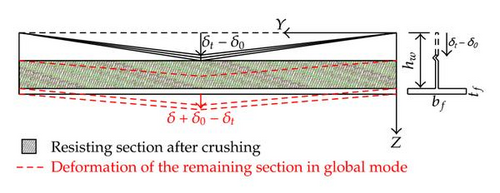
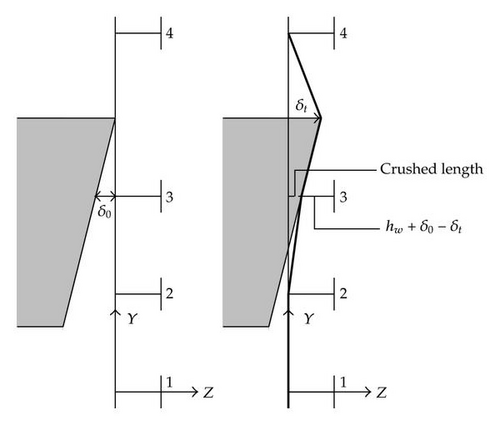
Of course, this formula has only to be applied if , otherwise beam k is not impacted during the local mode and the classic formulae of Section 5 remains valid. However, a correction is still needed to take into account the beginning of a new phase of motion. In fact, in (5.7) and (5.15), we have to evaluate and for the actual global displacement, that is, δ − δt and not for the total displacement δ, which also includes the displacements during the local phase. This concept is illustrated in Figure 27.
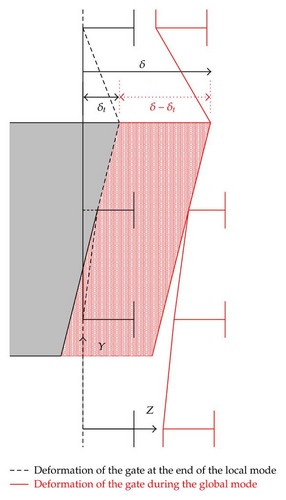
6.2. Total Resistance
- (1)
At the beginning, the progression of the striking vessel into the gate is allowed by local deformations of the structure. During this local phase, two different forces are evaluated:
-
During the local phase, the total resistance of the gate Pt is equal to the local one, which means that Pt(δ) = P (δ).
-
We assume that deformations remain local as long as Pglob(δ) > Ploc (δ). The transition between the local and the global mode occurs at the particular value δt, for which we have Pglob(δt) = Ploc (δt).
- (2)
For the values of δ greater than δt, the global mode is activated. The total resistance of the gate is still given by
(6.5)where- (i)
is obtained by formula (5.7) or formula (5.15) if beam k has not been impacted during the local phase; it should be noted that these equations are evaluated in δ − δt and not in δ (see Figure 27),
- (ii)
is obtained by formula (6.4) if beam k has been impacted during the local deforming mode,
- (iii)
Ploc (δt) is the total resistance of the gate at the end of the local phase.
- (i)
7. Numerical Validation
In order to validate all the developments described in the previous sections, we compare them to the results obtained by numerical simulations on two different gates. For each studied lock gate, two situations of collision have been considered: in the first case, the impact point E is located in the upper part of the gate; in the second case, it is positioned in the lower part.
7.1. Numerical Model of the Striking Vessel
As mentioned above, we are only interested by the worst damages that may be caused to the gate during the collision. So far, we are not concerned by the destruction of the striking vessel. Therefore, we conservatively assume that the ship is perfectly rigid and will not deform over the total impact duration.
For the numerical simulations, it is useless to deal with the entire ship. We only need to have a quite refined model of the bow. As explained in Section 2, the geometry of the ship is fixed with help of the five parameters p, q, φ, ψ, and hb (see Figure 28). Its mass M0 is noted and its initial velocity V0. For the present example, we have chosen the numerical values listed in Table 1. These parameters have been chosen in order to represent a classical ship for the inland waterways.
| p | q | φ | ψ | hb | M0 | V0 |
|---|---|---|---|---|---|---|
| 6 m | 8 m | 84° | 84° | 5 m | 4000 t | 2 m/s |
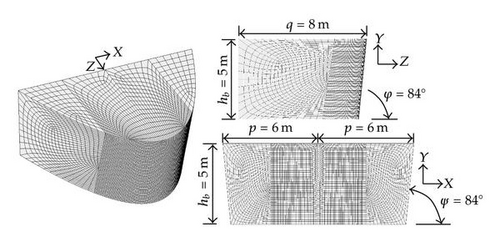
The numerical model of the vessel is shown in Figure 28. It is composed of 6955 Belytschko-Tsai shell elements, which are described in the LS-DYNA theoretical manual by Hallquist [17]. As it can be seen in Figure 28, the mesh is more refined in the central zone of the ship, where the contact with the gate is likely to occur. In this region, the mesh size is about 1 cm × 1 cm. In the remaining parts of the model, as they are not supposed to develop any contact with the impacted structure, the mesh is coarser.
The material used for modeling the bow is assumed to be rigid. It is defined with help of the classical properties of steel recalled in Table 2. These parameters are only required for defining the contact conditions between the ship and the gate. They are not used for calculating any deformation in the vessel, as the material is infinitely rigid.
| Property | Notation | Value |
|---|---|---|
| Density | ρ | 7850 kg/m3 |
| Young’s modulus | EY | 210 000 MPa |
| Poisson’s ratio | ν | 0.33 |
7.2. Numerical Model of Gate 1
- (i)
five transversal frames, which are irregularly distributed over the height H of the gate; their vertical positions along the vertical Y axis are shown in Figure 29(b);
- (ii)
six vertical frames, which are regularly placed over the length L of the gate; their locations along the transversal X axis are plotted in Figure 29(c);
- (iii)
twenty stiffeners distributed over the height H of the gate with an average space of 66 cm.
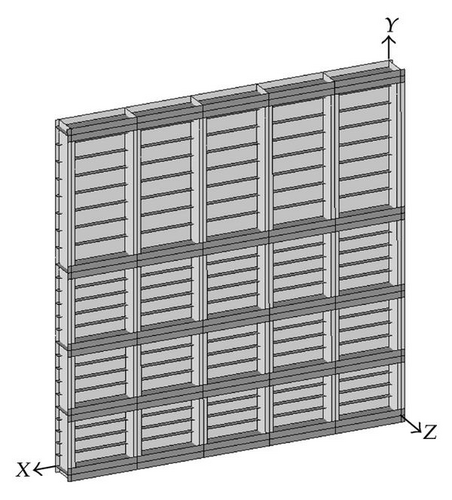
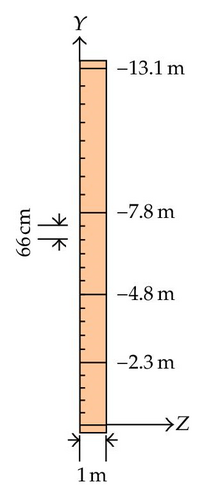
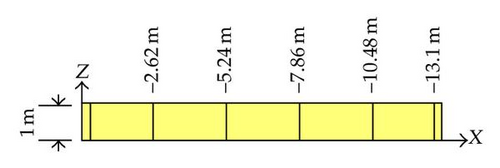
Other geometrical data are listed in Table 3. The corresponding notations are defined in accordance with the symbols introduced in Figure 3. Note that the transversal and vertical frames have a T-shaped cross-section, while the stiffeners simply have a rectangular one. The gate is modeled with help of 204226 Belytschko-Tsai shell elements. The mesh is quite refined, with a mesh size of 5 cm × 5 cm. Of course, it may appear excessive to use such a regular mesh over the entire structure, but it was required because we did not know in advance which part of the gate would be impacted by the ship. In order to avoid contact problems, this solution has been chosen.
| Element | Property | Notation | Value (mm) |
|---|---|---|---|
| Plating | Thickness | tp | 10 |
| Transversal frames | Web thickness | tw | 22 |
| Web height | hw | 1000 | |
| Flange thickness | tf | 22 | |
| Flange width | bf | 300 | |
| Vertical frames | Web thickness | tw | 22 |
| Web height | hw | 1000 | |
| Flange thickness | tf | 22 | |
| Flange width | bf | 500 | |
| Stiffeners | Web thickness | tw | 10 |
| Web height | hw | 200 | |
| Flange thickness | tf | 0 | |
| Flange width | bf | 0 |
The material used for gate 1 is defined to represent more or less the behaviour of steel. The elastic-plastic stress-strain curve may be divided in two distinct portions (see Figure 30). The first part of the curve corresponds to the elastic phase. The stress-strain curve is linear, with an inclination corresponding to Young’s Modulus EY. When the yield stress σ0 is reached, the plastic phase begins. The stress-strain curve is still linear, but the slope has changed and is given by the tangent modulus ET. In the present low velocity impact model, the strain-rate effect is not taken into account. The values of the different parameters are listed in Table 4.
| Property | Notation | Value |
|---|---|---|
| Density | ρ | 7850 kg/m3 |
| Poisson’s ratio | ν | 0.33 |
| Yield stress | σ0 | 240 MPa |
| Young’s modulus | EY | 210 000 MPa |
| Tangent modulus | ET | 1018 MPa |
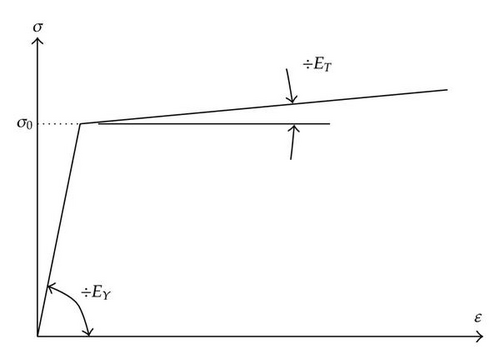
The support conditions are the ones described in Section 2, that is, displacements in direction Z are blocked in X = 0, X = L, and Y = 0.
7.3. Numerical Model of Gate 2
- (i)
five transversal frames, whose vertical positions along the Y axis are shown on Figure 31;
- (ii)
six vertical frames, regularly separated by a distance of 1.9 m;
- (iii)
twenty-six stiffeners, regularly separated by a distance of 50 cm.
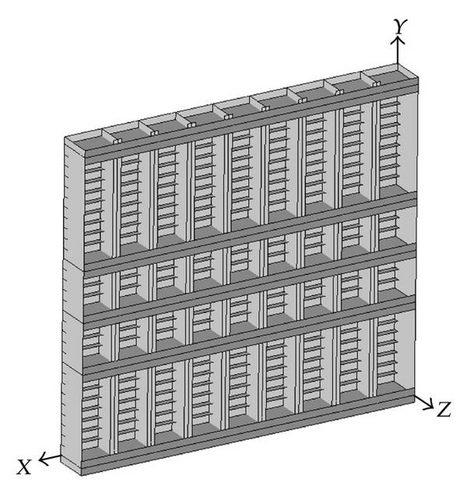
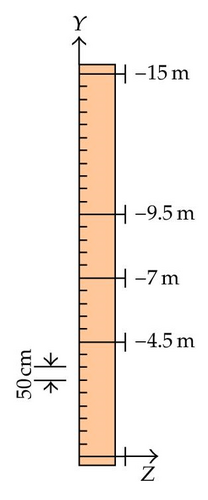

Other geometrical data are listed in Table 6. The gate is modeled by 92671 Belytschko-Tsai shell elements. The regular mesh size is 10 cm × 10 cm. The material model and the support conditions are the same as for gate 1.
7.4. Numerical Simulations
Four numerical simulations have been performed by using the finite-elements software LS-DYNA. Two simulations are required for each gate, according to the position of the impact point E. The transversal and vertical positions XE and YE of point E are listed in Table 5 for the different collision cases considered here.
| Simulation 1 | Simulation 2 | |
|---|---|---|
| Gate 1 | XE = 6.55 m | XE = 6.55 m |
| YE = 8 m | YE = 13.1 m | |
| Gate 2 | XE = 8.55 m | XE = 8.55 m |
| YE = 7.5 m | YE = 13.25 m | |
| Element | Property | Notation | Value (mm) |
|---|---|---|---|
| Plating | Thickness | tp | 12 |
| Transversal frames | Web thickness | tw | 12 |
| Web height | hw | 1800 | |
| Flange thickness | tf | 12 | |
| Flange width | bf | 400 | |
| Vertical frames | Web thickness | tw | 12 |
| Web height | hw | 1400 | |
| Flange thickness | tf | 12 | |
| Flange width | bf | 300 | |
| Stiffeners | Web thickness | tw | 12 |
| Web height | hw | 300 | |
| Flange thickness | tf | 0 | |
| Flange width | bf | 0 |
Concerning the resulting crushing force curves compared in Figures 32 and 33, simulation 1 corresponds to a ship impact happening in the lower part of the structure and simulation 2 to an impact in the upper one.
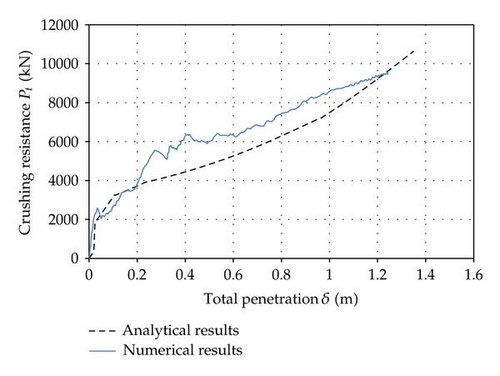
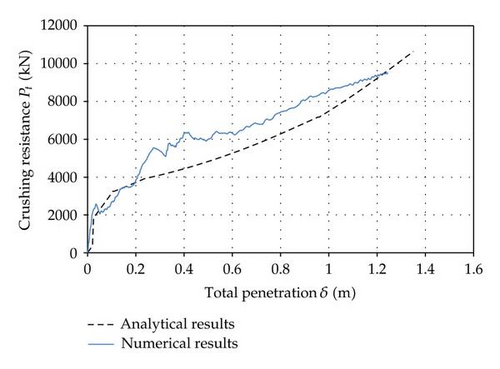
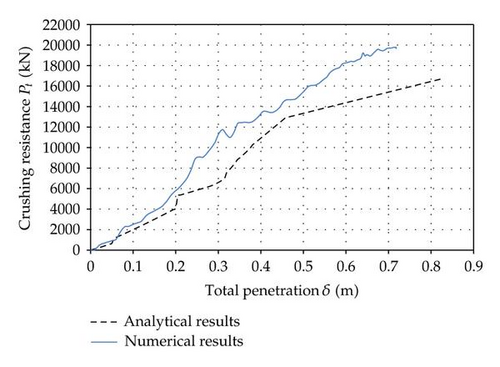
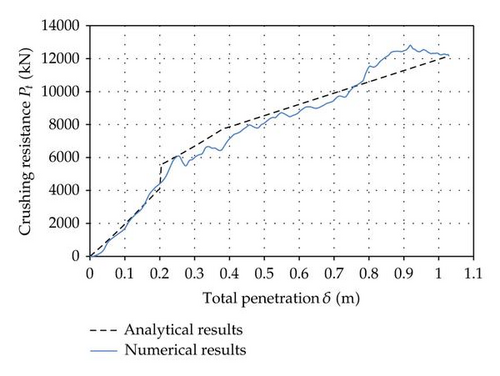
7.5. Comparison of Numerical and Analytical Results
In order to validate the analytical developments established in the previous section, we will make a comparison between the results provided by LS-DYNA and the ones predicted by our simplified method. The curves of interest are those showing the evolution of the crushing force Pt with the total penetration δ. The comparisons are plotted in Figures 32 and 33. The curves referenced as “numerical results” are those obtained by LS-DYNA, while the “analytical results” are derived by the present simplified approach.
- (i)
The resisting cross-sections are determined according to the recommendations of Eurocode 3. It seems that these rules are quite severe in the present case as the numerical simulations show that a greater part of the plating is actually collaborating to the resistance of the transversal frames.
- (ii)
We do not capture properly the deformation pattern of the vertical frames: we suppose that their role is limited to the application of the global displacements field, but we neglect the energy also dissipated through their own global deflection.
This last point is confirmed by the curves plotted on Figure 34, where we compare the energy dissipated by the different structural components of the gate. The numerical results are those given by LS-DYNA, while the analytical results are those predicted by the theoretical model of this paper. As it can be seen on this picture, the discrepancy is satisfactory for the plating, the stiffeners, and the transverse frames, but it is not really the case for the vertical frames. Our method underestimates the energy that these elements really dissipate, but this approximation remains conservative.
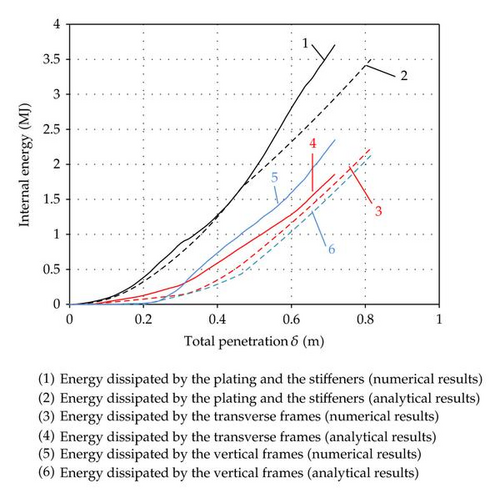
8. Conclusion
In this paper, we exposed a simplified procedure for assessing the resistance of a gate submitted to a ship impact.
- (i)
gates with single plating; structures with double plating or caissons are not covered by the present developments;
- (ii)
gates with a classical orthogonal stiffening system, that is, stiffeners and frames in the transversal direction and frames in the vertical direction;
- (iii)
gates supported on both sides by the lock walls and by a sill at the bottom of the lock.
The three former conditions have to be fulfilled for applying the methodology exposed previously. Concerning the striking vessel, it is modeled by using a certain number of parameters. The global bow shape is assumed to be a parabola, with given radii p and q, decreasing according to given stem and side angles φ and ψ.
The impacted structure is assumed to behave in two phases. At the beginning, when the indentation δ of the ship is not too wide, we suppose a localized crushing of some impacted structural elements. The plating and the stiffening system surrounding the initial contact zone are submitted to heavy deformations, but the remaining of the gate is still unaffected. In this case, we say that the structure withstands through a local deforming mode. For such a situation, the resistance is calculated by summing all the contributions of the activated superelements. As some references are already available in the literature, we have not reproduced all the developments concerning these superelements.
When the penetration δ becomes wider, the gate withstands through an overall movement implying the entire structure. In this case, we say that the resistance is provided through a global deforming mode. For the support conditions assumed presently, the required theoretical displacements fields have been exposed in detail. We also derived an equivalent mechanical model for evaluating the resistance in such a situation.
The transition between the local and the global deforming modes is assumed to occur at a given penetration δt, for which the collision force exerted by the ship during the local phase is sufficient to produce an overall displacement of the gate.
Finally, our presentation ends with a comparison between some finite elements numerical results and those obtained by the present simplified approach. In most cases, the procedure exposed here leads to a quite satisfactory estimation of the collision resistance. The predicted results are conservative, without underestimating too much the numerical values.
The main advantage of the methodology exposed here is to provide rapidly an evaluation of the collision resistance. The analytical curves plotted in Figures 32 and 33 are useful for knowing if a lock gate is able to behave satisfactorily to an impact of a ship with given initial velocity V0 and mass M0. With these curves, it is in fact possible to know the total needed indentation δmax required for dissipating the initial kinetic energy . If this value of δmax exceeds a given criterion, then we may suppose that the structure will not be able to withstand satisfactorily a collision with a vessel of mass M0 and velocity V0.
Of course, we have to be conscious that our simplified analytical method is only applicable at the predesign stage of a lock. For more advanced stages of a project, it is still necessary to resort to more advanced tools, like finite elements software.
List of Notations: Lower-Case Latin Notations
-
- a1:
-
- Horizontal or vertical dimension of a superelement defined by the impact point location and the supports of the struck structure
-
- a2:
-
- Horizontal or vertical dimension of a superelement defined by the impact point location and the supports of the struck structure (complementary to a1)
-
- b1:
-
- Vertical dimension of a superelement defined by the impact point location and the supports of the struck structure
-
- b2:
-
- Vertical dimension of a superelement defined by the impact point location and the supports of the struck structure (complementary to a2)
-
- beff:
-
- Effective width for calculating the section properties of a transversal beam
-
- bf:
-
- Flange width of a stiffener or a transversal frame
-
- hb:
-
- Vertical distance between the lowermost and uppermost decks of the striking ship
-
- hp:
-
- Collaborating width of the plating in the global deforming mode
-
- hw:
-
- Web height of a stiffener or a transversal frame
-
- k:
-
- Superscript used for referencing a particular property of superelement n°k
-
- n:
-
- Total number of superelements used for modeling the entire gate
-
- (p, q):
-
- Parameters defining the parabolic dimensions of the striking ship uppermost deck
-
- tf:
-
- Flange thickness of a stiffener or a transversal beam
-
- tp:
-
- Thickness of the plating
-
- tw:
-
- Web thickness of stiffener or a transversal frame
-
- tX:
-
- Equivalent plating thickness after smearing all the transversal stiffeners
-
- tY:
-
- Equivalent plating thickness after smearing all the vertical stiffeners.
Upper-Case Latin Notations
-
- E:
-
- Young’s modulus of the steel material constituting the gate
-
- Eext:
-
- External energy
-
- Eint
-
- Internal energy
-
- ET:
-
- Tangent modulus of steel
-
- EY:
-
- Young’s modulus of steel
-
- H:
-
- Total vertical height of the gate
-
- I:
-
- Bending inertia of a transversal beam
-
- L:
-
- Total transversal length of the gate
-
- M:
-
- Bending moment
-
- Mp:
-
- Plastic bending resistance of a transversal beam
-
- M0:
-
- Mass of the striking ship
-
- N:
-
- Axial force
-
- Np:
-
- Plastic axial resistance of a transversal beam
-
- Pglob:
-
- Total resistance of the gate in the global deforming mode
-
- Ploc :
-
- Total resistance of the gate in the local deforming mode
-
- Pt:
-
- Total collision resistance of the impacted gate
-
- W(X, δ):
-
- Transversal evolution of the displacement field in the global deforming mode
-
- WE(Y, δ):
-
- Vertical evolution of the displacement field in the global deforming mode
-
- (XE, YE):
-
- Impact point location on the gate
-
- (X, Y, Z):
-
- General coordinate system.
Lower-Case Greek Notations
-
- δ:
-
- Penetration of the striking ship
-
- δc:
-
- Penetration of the striking ship for which a second contact between the gate and the bow is established
-
- δt:
-
- Penetration of the striking ship at the transition between the local and the global deforming modes
-
- δmax :
-
- Maximal penetration of the striking ship required for completely dissipating its initial kinetic energy
-
- δ0:
-
- Initial distance between the bow and a transversal beam
-
- ϵu:
-
- Deformation for which the ultimate stress σu is reached
-
- ϵ0:
-
- Deformation for which the plastic limit σ0 is reached
-
- ϵij:
-
- Strain tensor
-
- θ:
-
- Cross-section rotation
-
- ν:
-
- Poisson’s ratio of steel
-
- ρ:
-
- Mass density of steel
-
- σu:
-
- Ultimate stress of steel
-
- σ0:
-
- Plastic limit of steel
-
- σij:
-
- Stress tensor
-
- ϕ:
-
- Stem angle
-
- χ:
-
- Curvature of a transversal beam
-
- ψ:
-
- Side angle.
Upper-Case Greek Notations
-
- Γ:
-
- Designation of the parabola describing the striking ship uppermost deck
-
- Δ:
-
- Total axial extension of transversal frame.




